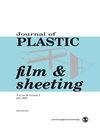Interaction of porous substrate and vegetable oil-based hydrophobic thermoset coatings during UV-polymerization
IF 1.5
4区 材料科学
Q3 MATERIALS SCIENCE, COATINGS & FILMS
引用次数: 0
Abstract
In the current study, we report the progress in developing new UV polymerizable hydrophobic biobased coatings from modified vegetable oil for porous substrates like paper and wood. The aim was to produce novel hydrophobic coatings on porous substrates and investigate how the porous nature of the substrates will be affected by different chemical formulations that penetrate into the interior of the substrate during the exposure to different intensities of UV light, and what hydrophobic properties that interaction will result in. The curing formulations were based on acrylated epoxidized linseed oil (AELO) as a prepolymer. For the UV polymerization, 1-hydroxycyclohexyl phenyl ketone (Irgacure 184) was used as a photoinitiator; isobornyl acrylate (IBA) and isosorbide methacrylate (IM) were used as bio-based diluents; hexadecyltrimethoxysilane (HDTMS), vinyl-polydimethylsiloxane (v-PDMS), triethoxyoctylsilane (TEOS) were used as hydrophobic additives and they were added in different concentrations to the AELO curing formulations. The formulations were then cured under UV light on wood and paper substrates. FT-IR analysis showed that the AELO resin was successfully polymerized on both paper and wood substrates, and by contact angle measurements it was found that the highest hydrophobicity was achieved for the coatings that contain HDTMS (108° in average). The layer thickness on wood substrates was in between 9 and 20 µm, and on paper substrates between 8 and 24 µm. Only about a 5° difference in contact angle was observed between the coatings with respect to change in diluents and different UV light intensity. All cured samples showed a good chemical resistance to acetic acid, citric acid and ethyl alcohol after 1 hour exposure; to acetone and ethylbutyl acetate after 10 s, and to benzine after 2 minutes. Outstanding hydrophobic behavior was observed for the HDTMS coatings, however, better physical properties were determined for the coatings containing v-PDMS and TEOS, on which the scratching was observed after the applied force of 1.5 and 0.6 N in comparison to HDTMS coatings (0.4 N). The resulting properties achieved for the AELO coatings indicated that it has a potential to be used for wood coating and packaging application.紫外光聚合过程中多孔基材与植物油基疏水性热固性涂层的相互作用
在目前的研究中,我们报告了用改性植物油开发新的可紫外光聚合的疏水性生物基涂料的进展。目的是在多孔基材上生产新型疏水涂层,并研究在不同强度的紫外线照射下,基材的多孔性如何受到渗透到基材内部的不同化学配方的影响,以及这种相互作用将导致什么疏水特性。固化配方以丙烯酸环氧化亚麻籽油(AELO)为预聚体。以1-羟基环己基苯基酮(Irgacure 184)为光引发剂进行紫外光聚合;采用丙烯酸异山梨酯(IBA)和甲基丙烯酸异山梨酯(IM)作为生物基稀释剂;以十六烷基三甲氧基硅烷(HDTMS)、乙烯基聚二甲基硅氧烷(v-PDMS)、三乙氧基辛基硅烷(TEOS)为疏水助剂,以不同浓度加入到AELO固化配方中。然后在紫外光下在木材和纸张基材上固化配方。FT-IR分析表明,AELO树脂在纸张和木材基材上都能成功聚合,通过接触角测量发现,含有HDTMS的涂层具有最高的疏水性(平均为108°)。木质基材上的层厚在9 ~ 20µm之间,纸质基材上的层厚在8 ~ 24µm之间。由于稀释剂的变化和紫外光强度的不同,涂层之间的接触角仅相差约5°。经1小时处理后,所有固化样品对乙酸、柠檬酸和乙醇均表现出良好的耐化学性;10 s后转化为丙酮和乙酸乙丁酯,2分钟后转化为汽油。HDTMS涂层具有优异的疏水性,然而,含有v-PDMS和TEOS的涂层具有更好的物理性能,与HDTMS涂层(0.4 N)相比,在1.5和0.6 N的作用力下观察到划痕。AELO涂层所获得的性能表明它具有用于木材涂层和包装应用的潜力。
本文章由计算机程序翻译,如有差异,请以英文原文为准。
求助全文
约1分钟内获得全文
求助全文
来源期刊

Journal of Plastic Film & Sheeting
工程技术-材料科学:膜
CiteScore
6.00
自引率
16.10%
发文量
33
审稿时长
>12 weeks
期刊介绍:
The Journal of Plastic Film and Sheeting improves communication concerning plastic film and sheeting with major emphasis on the propogation of knowledge which will serve to advance the science and technology of these products and thus better serve industry and the ultimate consumer. The journal reports on the wide variety of advances that are rapidly taking place in the technology of plastic film and sheeting. This journal is a member of the Committee on Publication Ethics (COPE).
 求助内容:
求助内容: 应助结果提醒方式:
应助结果提醒方式:


